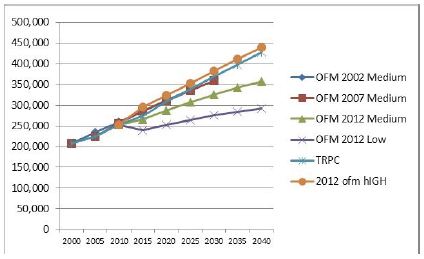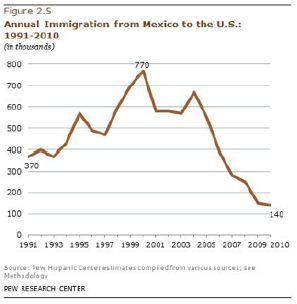|
"a bi-monthly journal of environmental news and commentary..."
Thurston County Population Growth Slows DownBy Jim Lazar
 Every five years, the state Office of Financial Management publishes a forecast of population growth for each county in the state. The counties that are subject to the Growth Management Act (GMA) are required to use these forecasts, and to provide for development within the range of the "low" to "high" sensitivity cases published by OFM. Every five years, the state Office of Financial Management publishes a forecast of population growth for each county in the state. The counties that are subject to the Growth Management Act (GMA) are required to use these forecasts, and to provide for development within the range of the "low" to "high" sensitivity cases published by OFM.
Five years ago, based on information then available, the Thurston Regional Planning Council (TRPC) adopted a forecast estimating that our County would grow from 224,000 people in 2005 to 427,000 in 2040. That forecast was used for the Sustainable Thurston workshops held in March and April (see companion article). That forecast has been the foundation stone for local transportation and land use planning.
One April 23, 2012, OFM released its most recent population estimate, again, following a low/medium/high framework. These are dramatically lower than before for Thurston County. In fact, the forecast used by TRPC for the "Sustainable Thurston" workshops follow the "high" forecast line, while I suspect the majority of Thurston County residents would prefer policies that keep population down below that level.
This graphic (above) compares the 2002, 2007, and 2012 forecasts from OFM to the forecast used by TRPC at the Sustainable Thurston workshops:
These differences are dramatic. While the Sustainable Thurston workshop assumed we would add 180,000 new residents, the "medium" OFM forecast is more like 102,000. The "low" forecast, which the County is allowed by the GMA to plan to, is only 40,000 new residents. Think about the difference in sprawl, infrastructure, stormwater impacts, water and air quality, school and park crowding and energy consumption that these differences involve.
The results for Thurston County are very different for four fundamental reasons:
- The recession and Eyman initiatives have reduced state revenues, thus constraining local employment growth;
- Young people are overwhelmingly preferring an urban (Seattle) environment over a suburban (Thurston County) environment;
- In-migration statewide has slowed dramatically (typically in-migration from other states and countries has provided about two-thirds of state population growth);
- We are reaching the capacity of I-5 to get more people to jobs in Pierce and King Counties, and there are no plans to increase capacity at the Nisqually River bridges. -}
Take a look at one of these factors: in-migration from Mexico. (below)
The opinion of the TRPC staff, as presented to the Council at a meeting on May 4, is that there is really little role for public input in the adoption of a population forecast. It should be "data driven." That implies that population growth is something over which we have no influence.
 I disagree, and you may also. Do we want to preserve agricultural lands to allow us to become food self-sufficient? Or, do we want to be a bedroom community to Fort Lewis and Tacoma with sprawling suburbs from the Nisqually River to Grand Mound? I disagree, and you may also. Do we want to preserve agricultural lands to allow us to become food self-sufficient? Or, do we want to be a bedroom community to Fort Lewis and Tacoma with sprawling suburbs from the Nisqually River to Grand Mound?
It seems to me that we can define, as a community, what level of growth we prefer. We can adopt land use zoning, codes and standards, and other policies to keep population growth and development from exceeding those levels.
For example, if each jurisdiction adopted the 65/10/0 storm-water standard (preservation of 65% of forest cover, maximum of 10% impervious surface, 0% off-site runoff) for all new development, we would accomplish three things. First and foremost, we would protect our rivers and streams from further damage to water quality and fish habitat. Second, we would reduce the subsidies that are paid by existing residents to correct the impacts of growth. Finally, because development costs would be higher, fewer new homes would be built and fewer people would move to our county. The point is that growth in population is not a "given" but rather it is something we can manage.
The difference in environmental impact between the "high" forecast (roughly the same as that used by TRPC for the Sustainable Thurston workshops) and the "low" forecast that would be achieved if aggressive growth management strategies were applied, would be pretty dramatic.
That's why it's called "Growth Management." Otherwise it would just be "Growth Accommodation."
Jim Lazar is an Olympia-based economist with a global consulting practice in energy efficiency, utility regulation, and transportation planning.
Back to Home page.
|

 Every five years, the state Office of Financial Management publishes a forecast of population growth for each county in the state. The counties that are subject to the Growth Management Act (GMA) are required to use these forecasts, and to provide for development within the range of the "low" to "high" sensitivity cases published by OFM.
Every five years, the state Office of Financial Management publishes a forecast of population growth for each county in the state. The counties that are subject to the Growth Management Act (GMA) are required to use these forecasts, and to provide for development within the range of the "low" to "high" sensitivity cases published by OFM.
 I disagree, and you may also. Do we want to preserve agricultural lands to allow us to become food self-sufficient? Or, do we want to be a bedroom community to Fort Lewis and Tacoma with sprawling suburbs from the Nisqually River to Grand Mound?
I disagree, and you may also. Do we want to preserve agricultural lands to allow us to become food self-sufficient? Or, do we want to be a bedroom community to Fort Lewis and Tacoma with sprawling suburbs from the Nisqually River to Grand Mound?